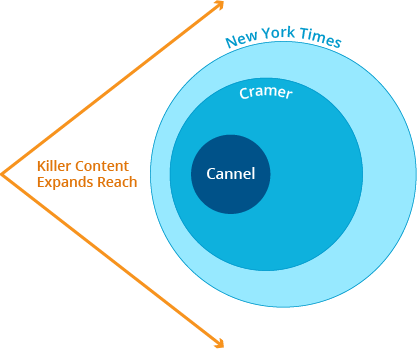One way for a small company to get noticed is to pick a fight with a well-known firm using the principles of content marketing. What I think of as a giant killer. This blog will show how the little guy, J Carlo Cannel pulled of huge coup by writing a letter to Jim Cramer (big financial influencer) and then getting it covered in the New York Times.
An investor’s letter to a company is not really news unless there is some other aspect to the story, but it is a form of content marketing that is used all the time in the financial industry. Carl Icahn, for example made a huge splash with his open letter to Apple CEO Tim Cook. One giant criticizing another was a big story.
Cannel’s firm, Cannell Capital, an asset management company has only $450 million of assets that own 9 percent of TheStreet.com. TheStreet.com is a small public company with a market cap of $81 million and a share price of $2.30 on 12/4. Hardly a media powerhouse. So how did Cannell get a story “Booyah! Activist Investor Hurls Purple Prose at Jim Cramer” on the front page of the New York Times business section? He did so by demonstrating some core principles of content marketing.
Principle 1: Ride the fame
The only reason this story was of interest to The New York Times is because it focused on Cramer, a well-known financial commentator and host of the Mad Money show on CNBC. Cramer is wild and crazy on the show and pulls no punches in criticizing or promoting companies.
If Cannell addressed his letter to the CEO of TheStreet.com, and didn’t mention Cramer, he would have gotten very little attention. Instead, Cannell focused on creating a showdown between him and Cramer, and that got the ball rolling.
For a giant killer content marketing program to succeed you must have a person of interest as your target.
Principle 2: Be creative
Cannell didn’t write a safe letter. Instead, he imitated Cramer’s wild and crazy act and went for the comic jugular. The key sentence: “In addition, you have enjoyed considerable non-pecuniary compensation such as perfumed sedan driver(s) and assorted assistants who spray ionized lavender water on your barren cranium.”
The reporters or editors who read this likely laughed out loud, as did millions of other people. For a giant killer program to work, you must be entertaining.
Principle 3: Back it up
The following sentence expresses the core of Cannell’s complaint: “The four year employment agreement you signed in November 2013 guarantees you total compensation of at least $3.5 million per annum—nearly 5% of the market capitalization of TST and more than the cumulative dividends expected to be paid out this year to common shareholders.”
Cannell is angry that Cramer is taking a large amount of money out of TheStreet.com yet only spending a moderate amount of time promoting the publication, partly because he is restricted by his agreement with CNBC. Cannell’s advice: quit CNBC and promote TheStreet.com.
Just picking a fight won’t work. You must have a strong case to get a giant killer program off the ground.
Principle 4: Find common ground
Finally, Cannell is tapping into a current of resentment, one that is both specific to Cramer and also applies to many successful people who are shameless self-promoters. This story got traction because Cramer has angered more than a few people and rubbed many the wrong way. To really have legs with a giant killer program, you must get the reader to join the attack.
Giant killer programs are bold but effective when done right. Kudos to Cannell.
If you have good examples of giant killer content marketing programs please tweet them to @DanWoodsEarly.
How can Evolved Media help me with:









